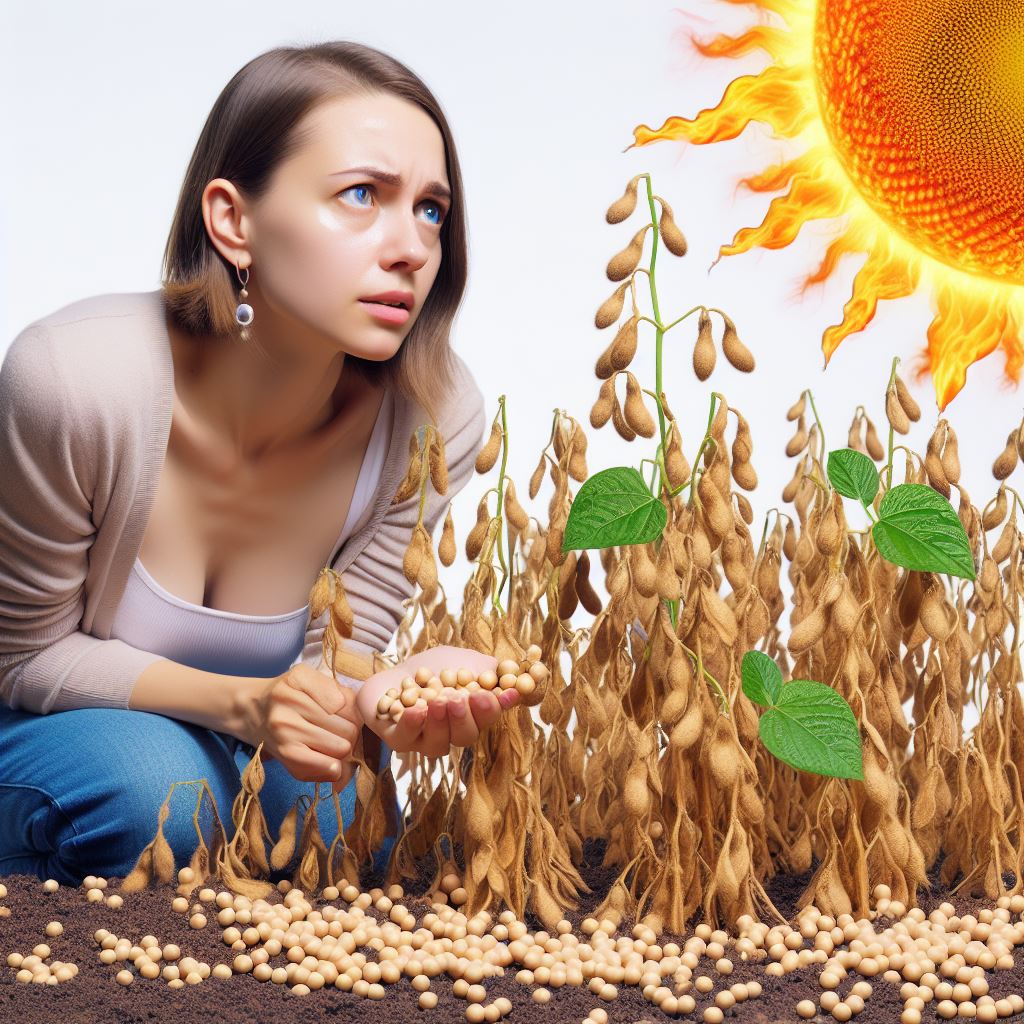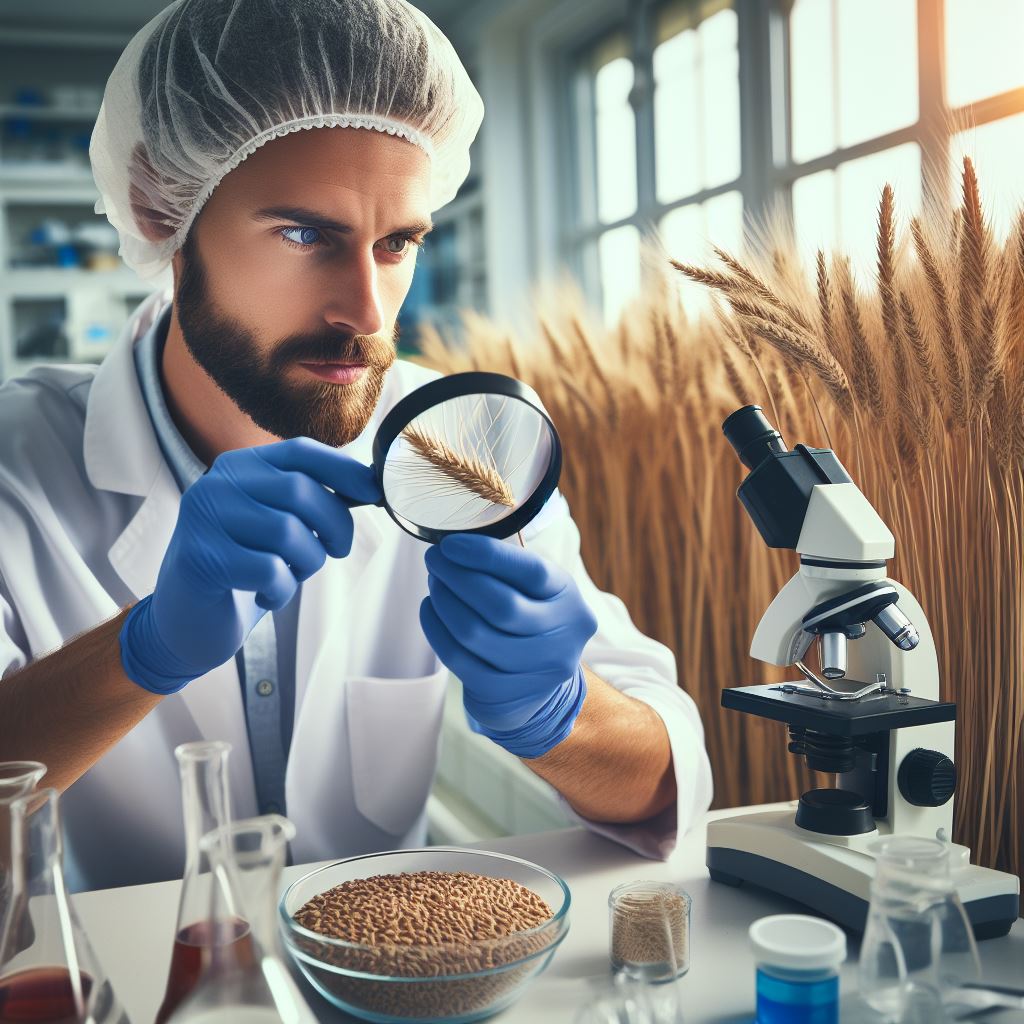Introduction
Let’s Explore Rising Heat: How Soybeans Struggle and Adapt
Introducing the topic of rising heat and its impact on soybeans in agricultural landscapes is crucial.
As temperatures climb, soybeans face numerous challenges and must adapt to survive and thrive in increasingly warm conditions.
Soybeans struggle with:
- Reduced photosynthesis and lower yields under heat stress.
- Heightened vulnerability to pests and diseases due to weakened defense mechanisms.
- Decreased water availability and compromised drought tolerance, impacting overall resilience.
To cope with rising temperatures, soybeans adapt by:
- Breeding for heat tolerance and early maturity to withstand hotter climates.
- Implementing irrigation systems and adopting soil moisture conservation practices to ensure adequate hydration.
- Utilizing shade cover and mulching techniques to mitigate the adverse effects of heat stress on plant growth and development.
Understanding these struggles and adaptations is essential for farmers and researchers alike.
By recognizing the challenges soybeans face and implementing effective strategies for adaptation, we can work towards a more resilient agricultural system capable of navigating the impacts of climate change.
The Impact of Rising Temperatures on Soybeans
When it comes to rising temperatures, soybean plants face numerous challenges that have a negative impact on their growth and overall productivity.
Let’s take a closer look at the general effects of these higher temperatures:
Reduced Yields
- The first noticeable consequence of rising temperatures on soybeans is a significant decrease in yields.
- Hotter temperatures interfere with the development of soybean pods, resulting in reduced production.
- High heat can cause flowers to drop prematurely, leading to a decline in the number of beans produced.
Shorter Growing Seasons
- Rising temperatures shorten the growing season of soybeans, impacting their overall growth and maturity.
- With a shortened growing season, soybean plants have less time to reach their full potential and yield.
- Shorter growing seasons also limit the time available for proper pod development and seed filling.
Increased Vulnerability to Pests and Diseases
- Warmer temperatures create a favorable environment for pests and diseases to thrive, affecting soybean plants.
- Pests like aphids and mites reproduce more rapidly in higher temperatures, leading to extensive damage.
- Diseases such as soybean mosaic virus and root rot become more prevalent and harder to control.
Therefore, the impact of rising temperatures on soybean plants is quite significant.
Reduced yields, shorter growing seasons, and increased vulnerability to pests and diseases are just a few of the negative consequences.
It is crucial for farmers and researchers to find innovative solutions to address these challenges and secure the future of soybean production.
Read: Climate Stress & Soil: What Can We Do?
Struggles of Soybeans in High Heat Conditions
When it comes to thriving in high heat conditions, soybeans face numerous challenges that hinder their performance.
These struggles can be attributed to various physiological changes that occur within the soybean plants.
Transform Your Agribusiness
Unlock your farm's potential with expert advice tailored to your needs. Get actionable steps that drive real results.
Get StartedIn this section, we will delve into the difficulties faced by soybeans under high temperatures and explore the alterations in their photosynthetic efficiency and water stress levels.
Decreased Photosynthetic Efficiency
One of the primary struggles of soybeans in high heat conditions is the decreased efficiency of their photosynthetic process.
As the temperature rises, the enzymes involved in photosynthesis become less efficient, leading to reduced carbon dioxide uptake and decreased production of carbohydrates.
This decline in photosynthesis poses a significant challenge for soybean plants, as carbohydrates are essential for growth, development, and yield.
With limited access to these vital resources, the overall productivity of soybeans is compromised under high heat conditions.
Increased Water Stress
Another significant struggle faced by soybeans in high heat conditions is the increased water stress.
As temperatures soar, the demand for water by the plants also intensifies.
However, the limited availability of water in the soil, combined with the accelerated evaporation rates, results in a water deficit for soybean plants.
This water stress adversely affects various physiological processes within the soybeans, including nutrient uptake, hormone synthesis, and overall plant growth.
As a consequence, soybean plants may experience stunted growth, leaf wilting, and, in severe cases, complete yield loss.
Impact on Reproductive Development
High heat conditions pose a significant challenge for soybeans during their reproductive development stage.
The heat can negatively impact the plant’s ability to set and retain pods, as well as impair pollen viability and reduce seed quality.
Under extreme heat stress, soybean plants may undergo flower abortion, resulting in reduced pod formation and subsequent yield reduction.
These limitations in the reproductive phase contribute to the overall struggle of soybeans in high heat conditions.
Reduced Root Development
Roots play a vital role in plant survival, especially under stressful conditions.
However, soybeans encountering high heat conditions struggle to develop a healthy and extensive root system.
The elevated temperatures hinder root growth, leading to a decreased surface area for water and nutrient uptake.
Consequently, soybean plants are more vulnerable to water stress and nutrient deficiencies, further intensifying their struggle in high heat conditions.
Altered Hormonal Balance
High heat conditions prompt changes in hormonal balance within soybean plants, which further adds to their struggles.
These alterations disrupt the normal growth and development processes, affecting overall plant performance.
For instance, increased levels of ethylene, a stress hormone, can induce premature leaf senescence, causing a decline in photosynthetic capacity.
Additionally, imbalances in auxin and cytokinin hormone levels can lead to distorted growth patterns and reduced crop yields.
Soybeans face several struggles when exposed to high heat conditions.
The decreased photosynthetic efficiency, increased water stress, impacted reproductive development, reduced root development, and altered hormonal balance all contribute to their struggle to thrive.
Showcase Your Farming Business
Publish your professional farming services profile on our blog for a one-time fee of $200 and reach a dedicated audience of farmers and agribusiness owners.
Publish Your ProfileUnderstanding these challenges is crucial for developing strategies to enhance soybean resilience and minimize the negative impacts of rising temperatures.
By addressing these struggles, researchers and farmers can work towards ensuring the productivity and sustainability of soybean cultivation, even in the face of climate change.
Read: Climate Change: Its Impact on Corn Yields in the US
Adaptations of Soybeans to Rising Temperatures
In order to survive and thrive in the face of rising temperatures, soybeans have developed a number of natural adaptations.
These adaptations allow certain soybean varieties to withstand heat stress better than others.
Root system development
- The root system of soybeans plays a crucial role in their ability to cope with higher temperatures.
- Soybean plants with well-developed root systems are better equipped to access water from deeper in the soil, helping them withstand heat-induced drought.
- This adaptation allows soybeans to maintain optimal growth and productivity even when faced with extreme heat conditions.
Flowering time
- Soybeans have the ability to adjust their flowering time in response to rising temperatures.
- Some varieties of soybeans are known to delay flowering when temperatures are too high.
- This adaptation helps to avoid exposing developing flowers and pods to excessive heat, ultimately ensuring successful pollination and seed production.
Increased chlorophyll content
- Soybeans have the ability to increase their chlorophyll content in response to heat stress.
- Chlorophyll is the pigment responsible for capturing sunlight and facilitating photosynthesis.
- By increasing chlorophyll levels, soybeans can enhance their photosynthetic capacity and maintain adequate energy production despite high temperatures.
Heat shock proteins
- Heat shock proteins (HSPs) are a group of proteins that help protect cells from damage caused by heat stress.
- Soybeans have the ability to produce higher levels of HSPs under heat stress conditions.
- These proteins play a vital role in maintaining the integrity and functionality of cellular structures, ensuring the survival of soybean plants under high temperatures.
Leaf morphology
- Soybean leaves exhibit specific morphological characteristics that allow them to tolerate rising temperatures.
- Some soybean varieties have leaf hairs or trichomes that reduce the amount of heat absorbed by the leaf surface.
- This adaptation helps to lower leaf temperature, minimizing the negative effects of heat stress on plant growth and development.
Carbon dioxide uptake
- Soybeans are able to take advantage of increased atmospheric carbon dioxide (CO2) levels that often accompany rising temperatures.
- Higher CO2 concentrations can enhance photosynthesis and overall plant growth in soybeans.
- This adaptation allows soybeans to potentially offset the negative impacts of rising temperatures on their productivity.
Most importantly, soybeans have developed a range of natural adaptations to cope with rising temperatures.
These include root system development, adjustments in flowering time, increased chlorophyll content, heat shock protein production, leaf morphology modifications, and the ability to capitalize on elevated atmospheric carbon dioxide levels.
Understanding and harnessing these adaptations can help scientists and farmers select and breed soybean varieties that are better equipped to thrive in a changing climate.
Read: Soil Health: Key to Climate Fight

Breeding and Genetic Engineering Efforts to Enhance Soybean Heat Tolerance
As rising temperatures become an imminent threat to soybean production, researchers are tirelessly working on breeding and genetic engineering techniques to enhance the heat tolerance of soybean plants.
These efforts are aimed at developing varieties that can withstand the challenges posed by increasing heat stress.
In this section, we will delve into the ongoing research and development in breeding and genetic engineering of soybeans for heat tolerance and highlight specific techniques and modifications used to improve soybean plants’ resistance to high temperatures.
Ongoing Research and Development
Scientists and plant breeders are actively involved in identifying heat-tolerant varieties and developing breeding strategies to enhance soybean plants’ ability to adapt to extreme temperatures.
The ultimate goal is to create heat-tolerant cultivars that can maintain high yields even under heat stress conditions.
Several approaches are being explored, including both conventional breeding methods and advanced genetic engineering techniques.
Conventional Breeding Techniques
Conventional breeding methods involve selecting and crossing soybean varieties with naturally superior heat tolerance traits.
Breeding programs carefully evaluate and select soybean plants that exhibit higher survival rates and better overall performance under high-temperature conditions.
This rigorous selection process helps identify genotypes with enhanced heat tolerance, which can be further used for creating new heat-tolerant varieties.
Another method used in conventional breeding is marker-assisted selection.
This technique involves identifying and selecting specific DNA markers associated with heat tolerance traits.
By using these markers, breeders can accelerate the development of heat-tolerant varieties by selectively breeding plants that carry the desired genetic traits.
Genetic Modifications for Heat Tolerance
In addition to conventional breeding techniques, genetic engineering offers promising solutions for improving soybean heat tolerance.
Through genetic modifications, scientists can introduce specific genes into soybean plants that enhance their ability to withstand high temperatures.
One genetic modification technique involves the introduction of heat shock proteins (HSPs) into soybean plants.
HSPs play a crucial role in protecting cells from heat stress.
By increasing the production of these proteins, soybean plants can better cope with elevated temperatures, maintaining their cellular integrity and overall performance.
Transcription factors are another target for genetic modification.
These proteins regulate the expression of various stress-responsive genes, including those involved in heat tolerance.
By modifying the activity of specific transcription factors, researchers aim to enhance the soybean plants’ overall heat tolerance capacity.
Furthermore, genetic engineering techniques allow scientists to introduce genes from other heat-tolerant species into soybeans.
This approach takes advantage of the genetic diversity present in nature and transfers heat tolerance traits from other plants to soybean varieties.
By doing so, researchers are able to improve soybeans’ ability to withstand high temperatures.
Breeding and genetic engineering efforts are crucial for enhancing soybean heat tolerance in the face of rising temperatures.
Through conventional breeding techniques and genetic modifications, scientists aim to develop heat-tolerant soybean cultivars that can sustain high yields even under heat stress conditions.
These ongoing research and development efforts provide hope for the future of soybean production, ensuring the availability of this vital crop in the face of climate change challenges.
Read: Managing Farms in Extreme Weather
Cultural Practices to Mitigate Heat Stress in Soybeans
In order to minimize the negative impacts of heat stress on soybean crops, farmers can implement a variety of cultural practices.
These practices not only help protect the plants from high temperatures but also enhance their ability to adapt and flourish in challenging conditions.
- Irrigation management: Implementing effective irrigation strategies is crucial in mitigating heat stress. Irrigating soybeans adequately helps maintain soil moisture and reduces the negative impact of high temperatures.
- Shading techniques: Providing shade to soybean crops can significantly alleviate heat stress. Techniques such as using shade cloths or planting cover crops can reduce direct exposure to sunlight and lower soil temperatures.
- Soil modification methods: Modifying the soil can contribute to alleviating heat stress in soybeans. Farmers can incorporate organic matter into the soil to improve its water-holding capacity and enhance its ability to retain moisture during hot periods.
- Interplanting: Planting soybeans alongside other crops, such as corn or sunflowers, can provide natural shade and reduce heat stress. The taller companion crops act as a shield, blocking excessive sunlight and reducing soil temperature.
- Cultivar selection: Choosing heat-tolerant soybean cultivars is crucial in minimizing the negative effects of rising temperatures. Farmers should select varieties specifically bred to withstand high heat conditions and display improved resilience.
- Crop rotation: Rotating soybeans with other crops in the field can help break disease and pest cycles and reduce stress on the plants. This practice also ensures better soil health and fertility, improving the ability of soybeans to cope with heat stress.
- Mulching: Applying organic mulch, such as straw or grass clippings, around soybean plants can help conserve soil moisture, regulate soil temperature, and reduce weed competition.
- Timing of planting: Planting soybeans earlier or later in the season, depending on the regional climate, can help avoid the peak heat stress period. This strategy helps in minimizing the duration of exposure to extreme temperatures.
- Weed control: Proper weed management is essential in reducing competition for water, nutrients, and sunlight. Weeds can exert additional stress on soybeans, making them more susceptible to heat stress.
- Pest and disease control: Implementing effective pest and disease control measures is crucial in minimizing additional stress on soybean crops. Insects and diseases can weaken plants, making them less resilient to heat stress.
By adopting these cultural practices, farmers can significantly minimize the negative impact of heat stress on soybean crops.
Implementing effective irrigation management, shading techniques, soil modification methods, and other strategies can help ensure the health and productivity of soybeans, even in challenging hot conditions.
Showcase Your Farming Business
Publish your professional farming services profile on our blog for a one-time fee of $200 and reach a dedicated audience of farmers and agribusiness owners.
Publish Your ProfileFuture Outlook for Soybeans in a Warm Climate
The future of soybean farming looks challenging in the context of rising temperatures.
However, several potential solutions, advancements, and strategies may emerge to ensure the sustainable cultivation of soybeans in a warmer climate.
Potential Solutions
- Developing heat-tolerant soybean varieties through genetic modification.
- Utilizing precision agriculture techniques to optimize water and nutrient management.
- Implementing advanced irrigation systems to cope with prolonged heatwaves and droughts.
- Adopting climate-smart farming practices to minimize the environmental impact of soybean cultivation.
Advancements in Research
- Scientists are studying the physiological and genetic mechanisms of soybean plants under heat stress.
- Research is being conducted to identify specific genes responsible for heat tolerance in soybeans.
- Biotechnology companies are investing in developing genetically modified soybeans with improved heat resistance.
- Efforts are underway to enhance the efficiency of photosynthesis in soybean plants, even in high-temperature conditions.
Strategies for Sustainable Cultivation
- Implementing crop rotation practices to improve soil fertility and reduce pest and disease pressures.
- Encouraging agroforestry systems, such as integrating soybean cultivation with shade-providing trees.
- Promoting intercropping methods to create microclimates that buffer soybean plants from excessive heat.
- Investing in research and development of biopesticides and biofertilizers to reduce dependence on synthetic chemicals.
Collaboration and Knowledge Sharing
The future outlook for soybeans in a warm climate relies heavily on collaboration between farmers, scientists, and policymakers.
Sharing knowledge, best practices, and research findings will be crucial to developing effective strategies.
International collaborations can facilitate the exchange of expertise, genetic resources, and adaptive technologies, ensuring soybean farming remains economically viable and sustainable in the face of rising temperatures.
The Need for Resilience
As temperatures continue to rise due to climate change, the resilience of soybean farming systems will be crucial.
Farmers will need to adapt their practices and engage in continuous learning to navigate the challenges.
Resilient soybean varieties will play a vital role in ensuring crop productivity and maintaining the economic stability of soybean-dependent regions.
Effective climate policies and incentives can encourage the adoption of sustainable practices at a larger scale.
A Collective Effort
The future of soybeans in a warm climate depends on collective efforts, including sustainable agricultural practices, technological advancements, and supportive policies.
By embracing innovation, investing in research, and fostering collaboration, we can ensure the sustainable cultivation of soybeans, providing a vital source of nutrition, economic livelihood, and environmental resilience in the face of rising heat.
See Related Content: AI in Agriculture: Facing Climate Change
Conclusion
Soybeans face numerous struggles as temperatures rise, but they have shown adaptability.
Despite the challenges, ongoing research and sustainable farming practices are vital for maintaining soybean productivity in a changing climate.
It is crucial to understand the genetic and physiological mechanisms that enable soybeans to withstand and adapt to higher temperatures.
Soybean farmers need to carefully select heat-resistant varieties and adopt practices such as irrigation management and shade provision.
Additionally, the importance of conserving soil moisture, reducing soil erosion, and improving soil fertility cannot be underestimated.
These practices not only protect soybeans from heat stress but also improve overall plant health and yield potential.
Furthermore, ongoing research is critical for developing new heat-tolerant soybean varieties and finding innovative solutions to combat rising temperatures.
The collaboration between scientists, farmers, and policymakers is essential to ensure the implementation of sustainable farming practices and create policies that support climate-resilient agriculture.
A changing climate poses significant challenges to soybean production, and its impact extends beyond the agricultural sector. Soybeans play a crucial role in food security, animal feed, and various industrial applications.
Therefore, it is imperative to prioritize research and sustainable farming practices to adapt and mitigate potential losses in soybean productivity.
By understanding the struggles and adaptations of soybeans in the face of rising heat, we can work towards building a resilient agricultural system that ensures a stable supply of soybean products for future generations.
It is a shared responsibility to protect this valuable crop and preserve its productivity in a changing climate.




